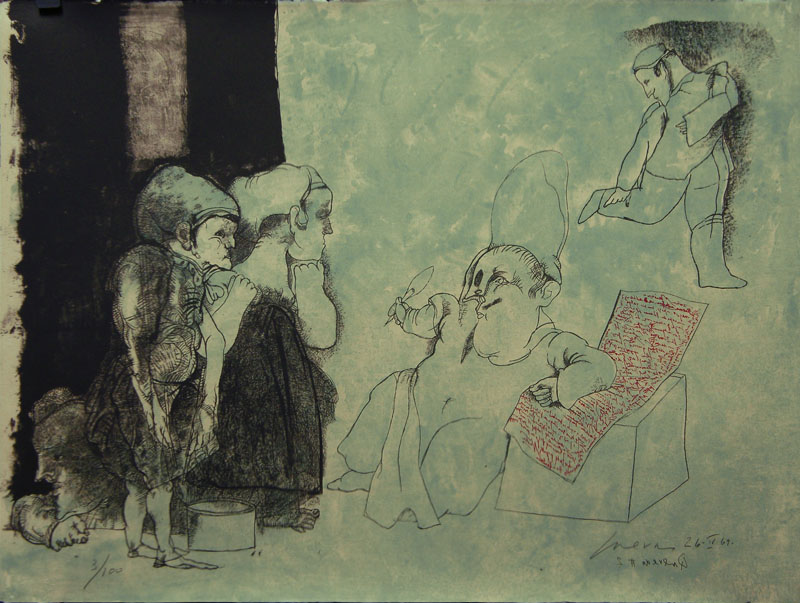Lo Feo de Este Mundo I is a color lithograph from 1969 by Mexican artist Jose Luis Cuevas. It is pencil signed by the artist and editioned 3/100. Lo Feo de Este Mundo I is one of sixteen lithographs included in the portfolio Homage to Quevedo published by Collectors Press in San Francisco. It was printed by Maurice Sanchez at Editions Press on ivory Crisbrook Watermark wove paper. The sheet of paper and the image measure 22-1/2 x 30 inches.
The title translates to “The Ugly of This World.” Cuevas depicts the gates of hell where a holy man wearing a mitre, lounges with a list of names beneath his elbow, checking the peasants who stand before him, who are waiting to find out their fate. Spanish satirist Francisco de Quevedo (1580-1645), who was born to nobility, has been labeled “Spain’s Jonathan Swift” for his critique of the aristocracy’s grip on the common man. He was accused by King Philip IV of placing a copy of his Carta a Luis XIII beneath the king’s napkin, then arrested and imprisoned, which affected his health and ultimately ended his life.
Quevedo's poems “Suenos” (Dreams) are a Goya-like nightmare where people of every class and trade are castigated without mercy and are driven to their personal hells. Quevedo commented: “Upon the whole matter, the policy of hell is admirable, where every man has his place, according to his condition.”
Jose Luis Cuevas, painter and printmaker, was born in Mexico City on February 26, 1934. Cuevas briefly attended the Escuela Nacional de Pintura, Escultura y Grabado 'La Esmeralda' in Mexico City and later studied graphic arts at the Institución de Enseñanza Universitaria also in Mexico City.
During the 1950s, Cuevas joined a group of young artists called the "Rupture-Generation", including Alberto Gironella, Enrique Echeverri, Pedro Coronel, Manuel Felguerez and Francisco Icaza. This politically-active group became opposed to the socialist artists favored by the Mexican government and rebelled against the official social-content mural art and became active in defining the contemporary artistic panorama of Mexico.
Cuevas’ first exhibition was mounted at the Galera Prisse in Mexico City in 1953. The following year he exhibited at the Pan American Union Building in Washington, DC. Cuevas was subsequently invited to work in various workshops worldwide, including the Tamarind Workshop in Los Angeles, California; and Poligrafa Obra Gráfica in Barcelona in 1981. He also worked at the Kyron Ediciones Gráficas Limitadas Kyron in Mexico City.
Cuevas had solo exhibitions in Washington, D.C.; Paris; New York; Rome; Venice; Sao Paulo; Vienna; Madrid; and Santiago. Awards included the Drawing Prize at the V Biennial of Sao Paulo in 1959; the National Prize of Science and Art of Mexico, the highest distinction of the Mexican Government for scientists and artists, in 1981; and the Ordre des Artes et des Lettres award from the French government in 1991. In 1997 he received the Tomas Francisco Prieto Award in Engraving bestowed by Queen Sofia, Madrid, Spain.
Cuevas also wrote a weekly column in Excelsior, one of the main news publications of Mexico City. The Jose Luis Cuevas Museum in Mexico City honors his contribution to art with a contemporary collection of his work.
Jose Luis Cuevas died in Mexico City on 3 July 2017.



